Subject: Joseph Smith and Mormon men
I am a Mormon with same-sex attraction. My wife is threatening divorce because I have confided this to her. Do you have any more information regarding this subject in the Mormon communities?
Re: Joseph Smith and Mormon men
It sounds like something right out of “Angels in America”––the tormented Mormon guy with the wife who figures it all out after they’ve transplanted to New York––but it is the reality for a great many gays and lesbians brought up in the Mormon faith, among the fastest growing religions across the globe. And actually, with conservatives charging that opening the door to same-sex marriage is opening the door to polygamy––and with a few renegade Mormon polygamists now using the Supreme Court sodomy decision to push their cause––I think we’re all becoming more aware that there’s always been a bizarre connection between the gay movement and the Mormons, as revolting as that might be to those on either side.
The Mormon church––officially the Church of Jesus Christ of Latter Day Saints––is one of the only truly American mainstream churches, in that its tenets were founded and evolved within the United States and it long ago passed the point of “cult” status with which the Church of Scientology and others still struggle. Mormons settled in Utah, where the church’s nerve center grew, but the church was founded in the 1830 in Fayette, New York, by Joseph Smith, the church’s first prophet. The history of the Mormon church is actually an interesting study in how homosexuality was much more accepted in the 19th century––and how homophobia exploded in America in the 20th century.
In his book “Same-Sex Dynamics Among Nineteenth Century Americans: A Mormon Example,” historian D. Michael Quinn shows how men and women easily expressed intimacy with one another in non-erotic ways in the 1800s in America, and how this was not only accepted but encouraged. Mormon church founder Smith, a polygamist, once wrote that male friends “should lie down on the same bed at night locked in each other’s embrace talking of their love,” which he said he often did himself. At around that time, in 1839, 27-year-old Mormon Elizabeth Haven wrote to her Mormon second cousin Elizabeth Bullard, “If I could sleep with you tonight, [I] think we should not be very sleepy… at least I could converse all night and have nothing but a comma between sentences, now and then.”
Quinn, a Mormon himself who has been attacked by the Mormon church for his work––he was excommunicated in 1992––stresses that these were not necessarily sexual relationships, but notes that, because such intimacy was accepted and encouraged, it made things much easier for those who did want to screw around. Sex between men and between women was commonplace, Quinn shows, and while it was technically “sinful” and sometimes even attacked by church leaders, it seemed to be grudgingly accepted, while heterosexual adultery was considered a much graver transgression.
These attitudes prevailed into the turn of the century. Quinn reveals how Even Stephens, director of the Mormon Tabernacle Choir in Salt Lake City from 1890 through 1916 and a lifelong “bachelor,” spent much of his life with young men––“boy chums,” as he called them––in relationships that sometimes lasted for years. Stephens often wrote in Mormon publications about “the picturesque manliness” of the choir’s uniform, describing the “grace they gave, what full manly outlines to the body and chest, what a form to admire they gave to the creature Man.” He regularly talked about his love for his boy chum of the moment, and it apparently raised few eyebrows.
According to Quinn, Utah–– today perhaps one of the most anti-gay states in the Union and one that still had a sodomy law on the books before the Supreme Court struck down such laws last June––didn’t have laws for any lengthy period specifically criminalizing sodomy until the U.S. government imposed them on the region in the late 1800s. Quinn says that even then, Mormon leaders and judges “were more tolerant of homoerotic behavior than they were of every other non-marital sexual activity,” which was more harshly punished.
What later happened to the Mormons is what happened to all of American society: The sensational Oscar Wilde trials at the turn of the century and the slow emergence of homosexuals from the closet over the next 50 years contributed to a growing, general fear and panic in American culture regarding people who conducted their sexual lives differently. By the 1950s, the Mormon church––once one that encouraged same-sex intimacy––was leading the way on electro-shock therapy to “cure” homosexuals. Quinn also notes that the Mormons’ desire to be accepted into the American mainstream––and their rejection of polygamy, under threat by the U.S. government––contributed to their becoming particularly obsessive about routing out sexual “deviants” of any kind.
Sadly, I’m not sure that pointing out all of this history to your wife and others will make them any more accepting of homosexuality––and certainly, for your wife, this is about her marriage––as they are products of the culture we live in today. But it is certainly instructive for you to know and learn in combating the viciously homophobic religious values that were ingrained in you. Not only was your faith, like many others, more accepting of same-sex attraction, but homosexuals have always been around and have at times been viewed as normal, healthy contributors to society. I think learning that past is the very beginning of the path of personal freedom that you are right now embarking upon.
Email Mike Signorile at Mike@Signorile.com.
Write Us!
Gay City News welcomes letters to the editor
and reserves the right to edit them
due to space constraints.
Please address letters to:
Editor@GayCityNews.com
Or, via mail, to
487 Greenwich St., Suite 6A
New York, NY 10013




































